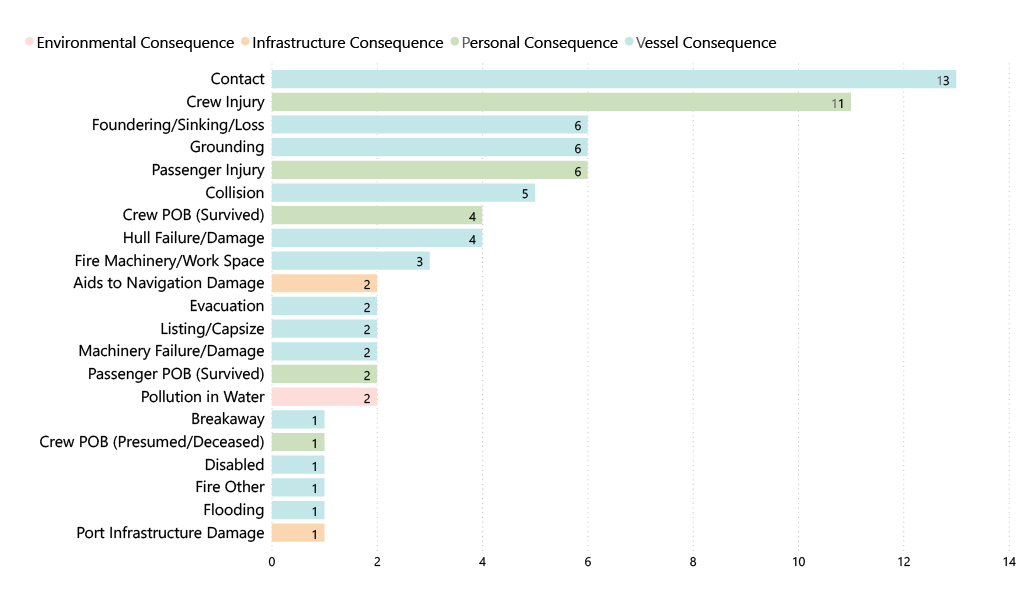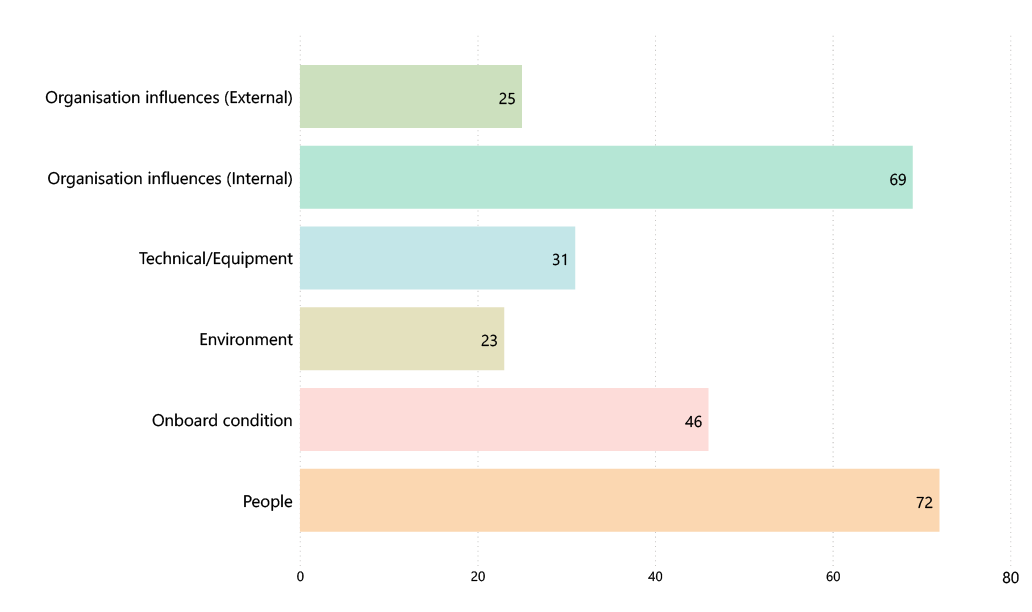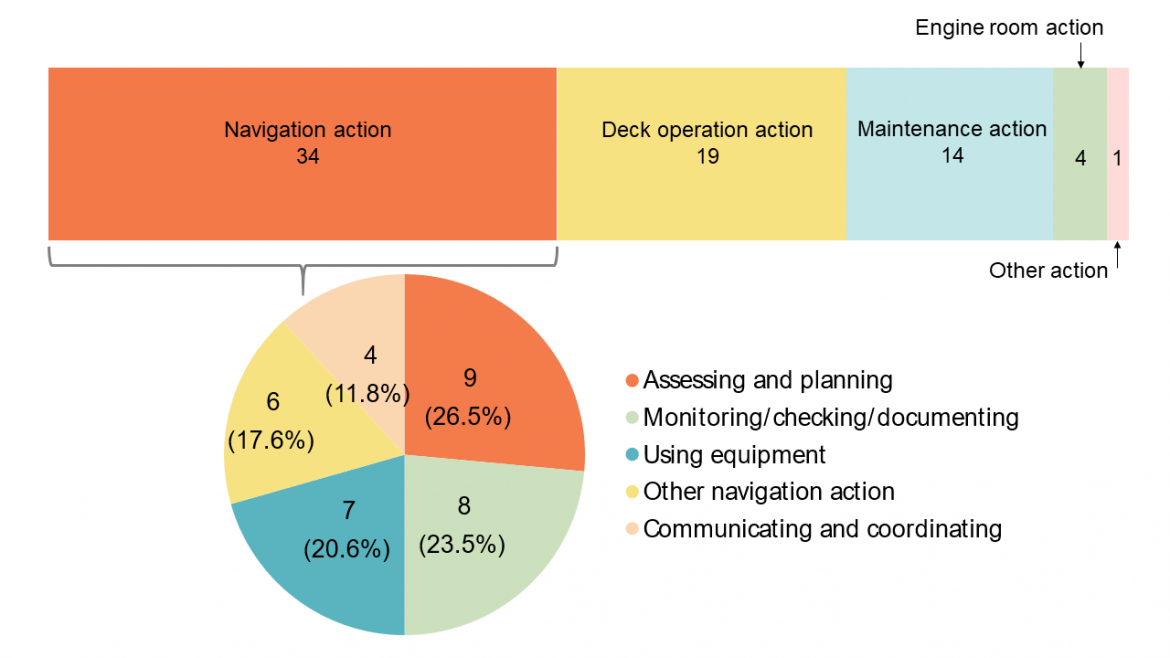This section of the report presents the findings of the analysis of safety factors identified from completed investigation reports using AMSA’s safety framework. The results of this analysis help to understand risks and identify if, and where, greater compliance focus needs to be applied.
This analysis also provides the risk basis for AMSA’s National Compliance Plan and helps to target our compliance focus.
The majority of Consequences (figure 28) from the 52 investigations coded were contacts (25%); crew injuries (21%); foundering/sinking (11.5%) and grounding (11.5%).
 Figure 28. Consequence category from the 52 coded investigation reports (2020)
Figure 28. Consequence category from the 52 coded investigation reports (2020)
A total of 266 safety factors were identified from the investigation reports analysed.
The majority of safety factors were related to people (27.1%), followed by internal organisational issues (25.9 %) and onboard conditions (17.3%).
The analyses presented in the next sections will focus on these three primary safety factors of concern.
 Figure 29. Categorisation of primary safety factors identified from investigation reports (2020).
Figure 29. Categorisation of primary safety factors identified from investigation reports (2020).
People
Overall, People actions was the most common primary safety factor identified from the 52 investigation reports analysed. People actions refer to observable behaviours such as decisions, actions and/or inaction by the crew that increased risk.
Of the 72 people actions identified, about half (47%) were navigation actions, followed by deck operation (26%) and maintenance action (19%).
Most navigation actions related to assessing and planning (26.5%), monitoring/checking/documenting (23.5%), or using equipment (20.4%).
Typical assessing and planning issues included no passage planning, incorrect assessment of the safety risk when taking certain actions or course and making inappropriate plans to rectify the situation. Problems with monitoring/checking/documenting include poor monitoring of the status of the voyage, poor lookout and lack of monitoring of environmental conditions.
 Figure 30. Breakdown of People categories with a focus on navigation action
Figure 30. Breakdown of People categories with a focus on navigation action
These decisions, actions and/or inaction by the crew usually result from onboard and/or organisational conditions which influence the final outcome.
Onboard conditions
Onboard conditions can influence decisions, actions, inaction or events that may increase risk. Onboard conditions are categorised into three primary safety factors and include knowledge, skills and experience; personal factors (such as drugs/alcohol, fatigue, preoccupation); and task demands (such as distractions, time pressures, incorrect task information). Figure 31 shows a further breakdown of the personal factors and task demands.
As per Figure 31, issues related to knowledge, skills and experience of crew made up about one third (35%) of onboard conditions. Most were related to situations where the crew did not have the required knowledge and/or skills to effectively use equipment. Personal factors (32.6%) and task demands (32.6%), similarly each comprised a third of onboard conditions.
 Figure 31. Breakdown of on board conditions categories with a focus on personal factors and task demands
Figure 31. Breakdown of on board conditions categories with a focus on personal factors and task demands
Personal factors included a wide variety of safety factors with most being due to drugs/alcohol (33%); preoccupation (20%),fatigue (13%) and motivation/attitude (13.3%). Task demands were usually due to distraction (40%) or time pressure (20%).
This data provides evidence of fatigue as contributing to some investigation outcomes.
Long working hours with restricted rest, broken or poor quality sleep, and long voyage lengths are detrimental to operational performance and possibly longer term wellbeing of the crew. A fatigued crew is much more likely to make a mistake, possibly a serious one.
Fatigue is an important part of crewing assessments and ensuring that the vessel is being crewed safely. AMSA has developed resources to support operators in managing fatigue on their vessels.
See our guidance about managing crew fatigue.
To help manage this, AMSA will commence an education campaign focusing on fatigue to support the DCV industry.
Internal organisational influences
Internal organisational influences comprised a large proportion (25.9%) of safety factors identified. This is an indication that a significant portion of the risks to safety reside at the organisational level.
Shortfalls in safety management processes was identified as forming the largest percentage of internal organisational issues. This includes problems associated with the processes an organisation uses to establish, maintain and otherwise ensure the effectiveness of its risk controls. Safety procedures (39.5%) and risk assessments (34.9%) comprised the majority of safety management processes issues.
 Figure 32. Internal organisational influences
Figure 32. Internal organisational influences
A separate analysis of safety management assessment data carried out by AMSA shows that poor, lack of or ineffective risk assessments are and continue to be major areas of concern.
Safety factors related to people management formed the second largest (20.3%) Internal Organisational issues. Within the people management, training and assessment (50%) was identified as the most frequently occurring safety factor.
This section of our website has resources to help you develop a safety management system and tools to assess the health of your safety management system.